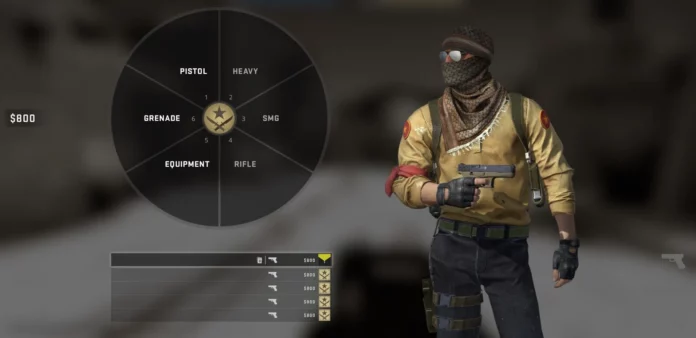Counter-Strike is a multi-layered game that goes beyond its surface-level fun and excitement. As players delve deeper into its intricacies, they realize the importance of meticulous planning, teamwork, and mastering the CS:GO economy. Understanding and strategizing around the in-game economy is essential for achieving success and moving closer to the professional level.
It’s important to note that the CS:GO economy we’re discussing here is distinct from the real-money business of CS:GO skins.
CS:GO Economy Explained: The Basics Let’s start by understanding how the entire system works in general.
At the beginning of a CS:GO match, each player is allotted $800. Various successful actions such as kills or successfully planting/defusing a bomb generate money. Even in rounds lost, teams receive a small sum, although significantly less than in winning rounds.
The general rule is simple: the more successful your team is from round to round, the more money you accumulate. This allows you and your teammates to make effective purchases when necessary, leading to even more victorious rounds.
There are two types of money earned in CS:GO: team money, which is divided among the players based on wins/losses and bomb-related actions, and individual money, which includes kill bonuses specific to each weapon. Each player can accumulate up to $16,000 in their individual funds.
In the first round, players can only buy pistols and equipment. The outcome of this pistol round determines your economic actions for subsequent rounds. It dictates whether you have the funds to purchase the best guns or if you should save money and aim to earn as much as possible using low-cost/high-reward weapons.
As the match progresses, you’ll make similar decisions after each round. Your strategy may involve spending everything at once with the risk of losing it or saving for a powerful strike in a few rounds. The current match score and the number of remaining rounds directly influence these economic decisions. Additionally, your opponents’ money is a significant factor to consider.
While the concept is straightforward, as is the case with competitive gaming, only practice can transform knowledge into skill. Our CS:GO economy guide provides step-by-step instructions to help you navigate this journey successfully.
Mastering the CS:GO Economy Step by Step To effectively comprehend and apply the CS:GO economy, it’s best to break down the wealth of information into smaller, interconnected segments. Let’s explore the CS:GO economy step by step.
Familiarize Yourself with the Buy Menu and Prices
The brief 30 seconds before each round aren’t meant for browsing the purchase interface in search of items to buy. Instead, utilize this time to determine what you need in the current situation. Familiarize yourself with the buy menu and its options outside the pressure of an actual match.
You can practice with bots and focus on purchasing weapons, adjusting their skill level or using specific CS:GO bot commands to create an engaging yet less intense training environment.
Consider utilizing CS:GO console commands that directly affect the buying process:
- mp_buytime 30: Adjust this value to increase the time available in the buy menu.
- mp_buy_anywhere 1: Activate this option with a value of 1 to have access to the shop anywhere on the map. Set it to 0 to return to the default setting.
Combine learning the buy menu with memorizing the prices. Your available funds should dictate your purchasing decisions. For example, if you have a certain amount, you should know which guns you can afford.
Don’t fret about being overwhelmed by the numerous numbers initially. You don’t need to memorize every single price. Instead, focus on the weapons you commonly use. Familiarity with their costs will streamline your decision-making process.
Remember, in-game prices are distinct from skin prices, which are a separate topic altogether. Here are some examples of weapon types, their corresponding terrorist and counter-terrorist options, and their prices:
| Type | Terrorist Weapons | Counter-Terrorist Weapons | Price |
|---|---|---|---|
| Pistols | Glock-18 | USP-S/P2000 | $200 |
| Dual Berettas | $300 | ||
| P250 | $300 | ||
| Tec-9/CZ75-Auto | Five-SeveN/CZ75-Auto | $500 | |
| Desert Eagle/R8 Revolver | $700/600 | ||
| Heavy | Nova | $1050 | |
| XM1014 | $2000 | ||
| Sawed-Off | MAG-7 | $1100/1300 | |
| M249 | $5200 | ||
| Negev | $1700 | ||
| SMG | MAC-10 | MP9 | $1050/$1250 |
| MP7/MP5-SD | $1500 | ||
| UMP-45 | $1200 | ||
| P90 | $2350 | ||
| PP-Bizon | $1400 | ||
Rifles | Galil-AR | FAMAS | $1800/2050 |
| AK-47 | M4A4/M4A1-S | $2700/3100/2900 | |
| SSG 08 | $1700 | ||
| SG 553 | AUG | $3000/3300 | |
| AWP | $4750 | ||
| G3SG1 | SCAR-20 | $5000 | |
Understand the Most Profitable Actions in a Round
To maximize your team’s earnings, it’s crucial to identify the actions that yield the most money. In CS:GO, there are two avenues for accumulating funds: team actions and personal efforts.
When your team wins a round, your focus should be on securing victory rather than individual kill bonuses. If you’re playing as a counter-terrorist, eliminate terrorists and defuse the bomb. As a terrorist, plant the bomb and eliminate the counter-terrorists. Winning rounds should be your primary economic strategy.
Win and Loss Bonuses for Counter-Terrorists
| Round after reset | Win | Bomb detonate | Total | Loss | Bomb plant | Total |
|---|---|---|---|---|---|---|
| First round | $3250 | $250 | $3500 | $1400 | N/A | $1400 |
| Second round | $3250 | $250 | $3500 | $1900 | N/A | $1900 |
| Third round | $3250 | $250 | $3500 | $2400 | N/A | $2400 |
| Fourth round | $3250 | $250 | $3500 | $2900 | N/A | $2900 |
| Fifth round | $3250 | $250 | $3500 | $3400 | N/A | $3400 |
Win and Loss Bonuses for Terrorists
| Round after reset | Win | Bomb detonate | Total | Loss | Bomb plant | Total |
|---|---|---|---|---|---|---|
| First round | $3250 | $250 | $3500 | $1400 | $800 | $2200 |
| Second round | $3250 | $250 | $3500 | $1900 | $800 | $2700 |
| Third round | $3250 | $250 | $3500 | $2400 | $800 | $3200 |
| Fourth round | $3250 | $250 | $3500 | $2900 | $800 | $3700 |
| Fifth round | $3250 | $250 | $3500 | $3400 | $800 | $4200 |
Disastrous rounds are inevitable, even for top-tier teams. There may be occasions where your opponents have several successful rounds, depleting your team’s budget. During such times, focus on the most profitable actions.
CS:GO weapons offer varying kill bonuses. Often, more difficult kills result in higher rewards. Consider your personal skills and choose weapons accordingly. Practice with different lucrative guns in matches against bots to prepare for multiplayer challenges.
Here are some examples of kill rewards for each weapon type in the game:
| Galil AR | $300 | MP9 | $600 |
|---|---|---|---|
| FAMAS | $300 | PP-Bizon | $600 |
| AK-47 | $300 | MP7 | $600 |
| M4A4 | $300 | UMP-45 | $600 |
| M4A1-S | $300 | P90 | $300 |
| SG 553 | $300 | Sawed-Off | $900 |
| AUG | $300 | MAG-7 | $900 |
| G3SG 1 | $300 | Nova | $900 |
| SCAR-20 | $300 | XM 1014 | $900 |
| SSG 08 | $300 | M249 | $300 |
| AWP | $100 | Negev | $300 |
| Glock-18 | $300 | Decoy | $300 |
| USP-S | $300 | Flashbang | $300 |
| P2000 | $300 | Smoke | $300 |
| P250 | $300 | HE | $300 |
| CZ75-Auto | $100 | Molotov Cocktail | $300 |
| Five-Seven | $300 | Incendiary | $300 |
| Tec-9 | $300 | Kelvar Vest | – |
| Dual Berettas | $300 | Kelvar + Helmet | – |
| Desert Eagle | $300 | Zeus x27 | – |
| R8 Revolver | $300 | Knife | $1,500 |
| MAC-10 | $600 | Defuse Kit | – |
Master the Art of Saving Money
In CS:GO, there are several economic strategies to consider based on your budget, match plans, and risk tolerance:
- Full Buy: This ideal scenario occurs when you have ample funds to purchase all necessary weapons and equipment for your team. Each player can have their preferred weapon and full gear. However, be cautious as losing the round means losing everything, and you may not have the resources for another Full Buy in the subsequent round. It’s safer to opt for a Full Buy when you still have some reserve funds. Assess the risk and use this strategy when you have a higher chance of success.
- Quasi Buy: In situations where your team can’t afford a Full Buy or wants to minimize risks, a Quasi Buy is a viable option. Players should divide their roles accordingly. Some can opt for rifles and armor, while others can invest in SMGs for higher kill bonuses. It’s even possible to choose better pistols to conserve money for future rounds.
- Force Buy: When your team is struggling with financial balance, such as after a Full Buy loss, taking risks with a Force Buy can be a strategic move. Force Buy involves investing in the most rewarding weapons that still fit within your budget. SMGs are commonly chosen as they offer winning chances without exorbitant costs. Depending on personal preferences, upgrading to better pistols may also be worthwhile. The success of a Force Buy depends entirely on your performance. A win can allow you to transition back to a Full Buy strategy, while a loss may require downgrading to an Eco/Full Save approach for an extended period.
- Eco: An Eco round is selected when your budget is severely limited, but you aim to earn more than the losing round bonus. During an Eco round, players typically purchase pistols and possibly some utility items like grenades. While losing the Eco round without any additional bonus is expected, each kill during this round is highly rewarding. CS:GO esports history showcases instances where teams have won Eco rounds and completely turned the tide of the match in their favor.
- Full Save: As a last resort strategy, a Full Save involves buying nothing at all. This desperate approach provides minimal chances of earning any bonus, and the team’s recovery relies heavily on the overall match situation. However, a Full Save is not a total disaster, and the team still has an opportunity to bounce back. The success of this strategy depends on the context of the match.
CS:GO offers strategic freedom, allowing you to shuffle economic scenarios to develop a successful match strategy. It’s crucial to discuss these aspects with your team to coordinate your actions effectively. Professional esports teams often have dedicated trainers who specialize in managing the team’s economy. In amateur teams, one player can take on this role.
Thank you for taking the time to read our article. To stay up-to-date with the best esports news website that caters to your individual preferences and comfort, we kindly recommend following TalkEsport on Google News & Twitter.


